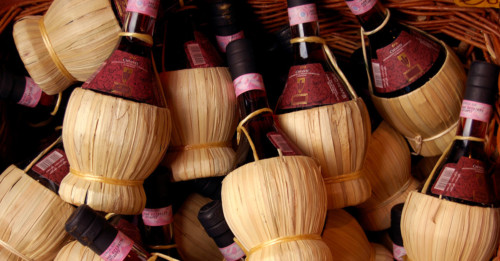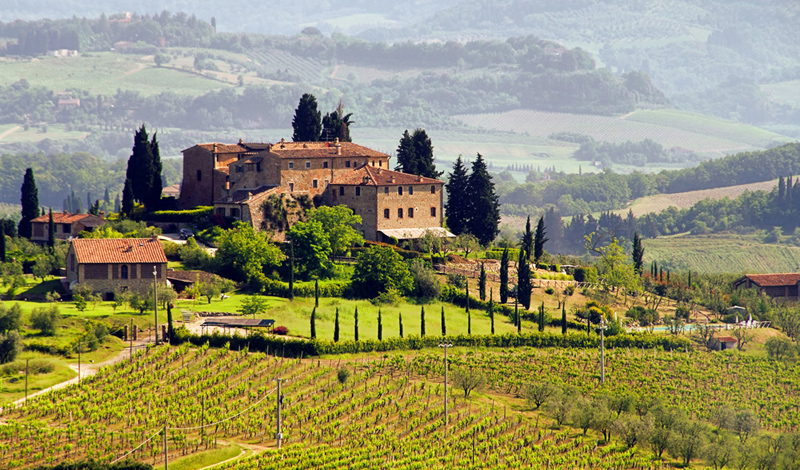An iconic, food-friendly Italian red wine, Chianti can range in price from $10 a bottle to upwards of $50 for higher-end versions. In recent decades, Chianti has outgrown its old-school straw basket image from the 1970s, and has evolved past being an Anthony Hopkins reference in Silence of the Lambs.
Looking for a bottle to drink? Check out our regularly updated list of the best Chianti bottles!
Chianti In 60 Seconds:
- The Chianti region is landlocked in central Italy and includes seven sub-regions.
- Sangiovese, a red wine grape that’s indigenous to the Tuscany region, is the dominant grape in Chianti.
- Chianti can be cellared anywhere from five to ten years and beyond, depending on its quality level.
- Chianti typically has fresh, red fruit flavors with a touch of spiciness. Earthy and savory notes take more of a front seat in versions aged in oak.
Where is the Chianti Region?
Chianti is located in the Tuscany region of central Italy, roughly 60 miles inland from the Ligurian Sea on the country’s west coast. Florence, Chianti’s closest city, is less than an hour’s drive away, making the region a popular destination for wine-loving tourists. The Chianti region is known for its sweeping landscapes, burning hot summers, and its wealth of art and food history. (Think: olive oil and Michelangelo’s David.)
Like most other Old World wines, Chianti is named for its region of origin rather than the grape used to make it, which in this case is Sangiovese.
What Does Chianti Taste Like?
To be labeled Chianti, the wine must be produced in the Chianti region and made from mostly Sangiovese grapes. In most instances, winemakers choose to use Sangiovese entirely, but in vintages where balance is needed, native grapes such as Canaiolo and Colorino are included in the blend. Occasionally, international varieties such as Cabernet Sauvignon, Merlot, and Syrah also feature.
Younger expressions of Chianti present red fruit flavors such as red currant, raspberry, or plum. Roasted or sun-dried tomato is another common tasting descriptor. With age, Chianti develops rustic, earthy notes such as dried flowers or clay pot. Chianti is medium-bodied and high in both tannins and acidity, making it ideal for food pairings.
The Differences Between Chianti and Chianti Classico
The two most common versions of Chianti are Chianti and Chianti Classico. The latter is the more refined of the two, produced from grapes harvested in the region’s best vineyards. Much like any Old-World appellation, there are a number of sub-appellations to explore.
Chianti DOCG Guide
Chianti DOCG contains at least 70 percent Sangiovese and is somewhat of a catchall appellation for wines from across the region (not including Chianti Classico). If the grapes are grown exclusively in one of the seven sub-zones, producers can choose to add the name of the sub-zone on the label. The subzones are:
- Chianti Colli Aretini
- Chianti Colli Fiorentini
- Chianti Colli Senesi
- Chianti Colline Pisane
- Chianti Montalbano
- Chianti Montespertoli
- Chianti Rufina
Chianti Superiore
These wines are produced within Chianti DOCG but are made using grapes from lower-yielding vineyards.
Chianti Riserva
Chianti Riserva is another subset of Chianti DOCG and is used for wines aged for at least two years before release.
Chianti Classico DOCG Guide
Wines designated as Chianti Classico DOCG contain at least 80 percent Sangiovese and are considered to be the highest-quality offering from the region. The grapes used in Chianti Classico wines are typically grown at higher elevations than those for Chianti DOCG. Bottles of Chianti Classico are branded with a symbol of a black rooster, or gallo nero.
Chianti Classico Annata
Annata wines are the first of three Chianti Classico subcategories and the lowest on the pyramid. They must have a minimum alcohol content of 12 percent ABV, and must age in barrels for at least 12 months.
Chianti Classico Riserva
Wines from the middle tier are required to undergo at least 24 months of aging, including at least three months in the bottle, before being released to the public.
Chianti Classico Gran Selezione
Gran Selezione is the newest and highest level within the Chianti Classico DOCG designation. Gran Selezione wines must age for a minimum of 30 months, at least three of which in bottle. This category also requires wines to be made entirely from estate-grown grapes, and a tasting panel must approve the final product before it goes to market.
The Best Food to Pair with Chianti
Like any classic Italian wine, look no further than authentic Italian food — anything with a tomato base allows for the fruitiness of the wine to shine. While pairing regional wine and food is an easy rule to remember, Chianti is well suited to a wide variety of foods because of its medium-body and complex, savory characteristics. In particular, its high tannins make it perfect for rich roasts, meat off the BBQ, or even an indulgent charcuterie spread.

